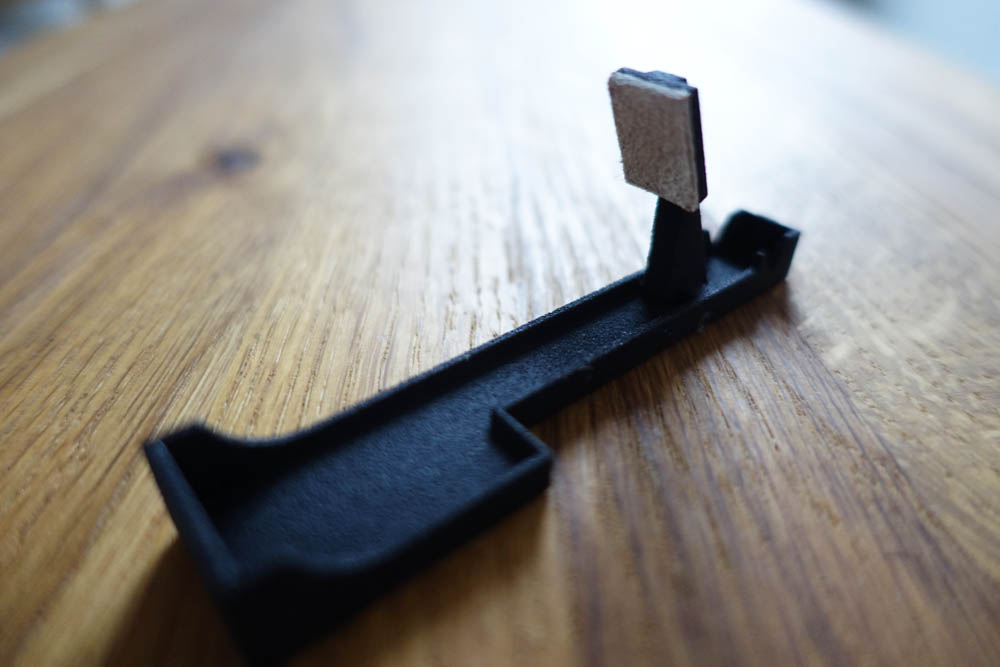Melodica Muffler, and More?
- This topic has 8 replies, 3 voices, and was last updated 7 years, 1 month ago by
 Alan Brinton.
Alan Brinton.
-
AuthorPosts
-
November 29, 2016 at 9:24 pm #7871
 Alan BrintonParticipant
Alan BrintonParticipantI believe that I have solved the problem of how to lower the volume of your melodica. This is best effected with a melodica that is dedicated to this purpose. I have conducted only a very few simple experiments, but I think they suffice to demonstrate that this will work. I had this idea while working on vintage Italian melodicas such as the Chordiana. On the old instruments, gasket material eventually gets crumbly and falls apart. After replacing gaskets, I noticed that the keys are clacky while playing. This is because narrow strips of the same kind of gasket material run the length of the instrument below the open ends of the keys, one in the front under the white keys, and one further back for the black keys. These strips have rotted away and need to be replaced (unless you like the clacking). This is a common feature of melodicas.
It occurred to me that replacing these strips with thicker strips, or adding an additional layer would shorten the draw of the key. We all know what happens when a key is partially released. This is a bending technique, but it also lowers the volume of the note. Some early vintage models, notably the Clavietta, but also some early Yamaha/Tokai Gakki Pianicas, have a shorter draw and are also lower in volume than 21st century melodicas. At least in theory, the shorter the draw, the easier it should be to bend notes and to produce some other effects, which suggests that changing the thickness of these strips may have other applications. So might changing their texture, which I found to be the case in my experiments.
Here you see the strips I’m talking about on a vintage Suzuki M-32. These are the original strips. The Japanese used better material.
Okay, so, working with just one key, I first tried a couple of thicknesses of foamy gasket tape, layered over the original strip. This provided a cushioning effect, which might have some advantages, but which only very slightly lowered the volume of the note.
I then considered trying a firmer silicone tape but decided instead to go directly to a material that has no cushioning effect whatever, namely the good old U.S. Penny:
Here’s the result, penniless sound first, pennied sound second:
https://soundcloud.com/abrinton/pennies-from-heaven
I hope that link works. Finally, it seems to me that the best approach is probably either a relatively hard strip with just enough give to avoid clacking, or a metal or plastic strip beneath a thin soft layer of gasket tape.
November 30, 2016 at 9:20 am #7877 Alan BrintonParticipant
Alan BrintonParticipantI am experimenting now with some other materials: wood, cardboard, and double-sided foam tape. But it’s 2:20 AM, so I’ll call it a day.
December 3, 2016 at 8:01 pm #7901 Alan BrintonParticipant
Alan BrintonParticipantThis melodion is actually the Samick version of a Suzuki M-32, this one, with the ends refinished in black, which I’ll now use as my silenced melodica:
Here’s a quick view of the modification, which required removing all the keys:
Very easy, although removing and replacing all the keys is laborious.
The operation is a success. This melodica is now quieter, though not radically so. That would require thicker strips. The key action is shorter, and it’s now also easier to bend notes, including high notes.
The sound of this Samick has been made softer and more mellow. One of my issues with high end Suzukis is the sound being a little bit edgy and sometimes harsh. This is a reservation that I have about one of my favorites, the Suzuki made Kawai 25A. I have the same issue with the M-37C. Replacing or adding to these strips on those models might be a way to address that issue.
December 3, 2016 at 9:23 pm #7905 Alan BrintonParticipant
Alan BrintonParticipantSamick A-27, not M-32!
February 20, 2017 at 5:12 pm #8273Dee Cook
ParticipantI have just spotted a few vintage Samick-36 models on ebay, and saw one I haven’t seen discussed on this forum – A Samick Melodihorn M-36 N. It’s in a cloth case, black and yellow.
The other 36 key Samicks I found are an SM-36A (pink edges, red back) and an M-36A. Anyone familiar with these, especially the N model?Comments re sound and quality?
I’m assuming, based on forum discussions that they are similar to Suzuki 36 models of the same era?
Thanks for any advice anyone can offer.
February 20, 2017 at 7:15 pm #8275 Alan BrintonParticipant
Alan BrintonParticipantI have several Samick versions of Suzuki Melodions. They have the same design as the original Suzukis, but they seem to have been manufactured in Korea. I have taken them apart and made comparisons. My experience is this: the Samicks I have examined (played, taken apart, etc.) are not as good as the original Suzukis and don’t sound as good. Not bad, but not as good. The finish work is rougher on the Samicks, and the parts do not all fit together as well. If there’s a particular model of Suzuki that you want and simply can’t find and there’s a Samick version available, it is a reasonable approximation. When Yamaha moved the manufacturing of its P-25, P-32, and P37 models to Indonesia, the same standards were maintained. But Suzuki seems to have just provided the design and sold the rights to manufacture in Korea to Samick. My Samick 36 is the Samick Melodihorn 36, for which I have a review here under Reviews. I don’t know whether the N suffix makes a difference. Kawai also has made (or sold under its brand) variants of Suzuki Melodions. The one model I’ve examined is the Kawai 25-A, which is comparable in sound and finish to the other metal tray Suzukis. It was manufactured in Japan.
Suzuki 36 models are all pretty good, I have all of them, if I’m not mistaken. And they are not hard to find. My personal preference is for the blue and white model that was made from 1974-1985.
February 26, 2017 at 1:50 pm #8308 DarenKeymaster
DarenKeymasterGood work Alan! I’m currently experimenting with materials for cushioning the keys. A layer of soft leather under 1mm felt works well, but I’m sure there’s more modern ways available now, such as your foamy gasket/silicon tape.
To take your idea a bit further, you could try fixing gasket material, leather, or other sound deadening material to the pads of the keys as well. This would have the dual effect of shortening the key depth and also absorbing some of the sound as it leaves the instrument
February 26, 2017 at 1:55 pm #8310 DarenKeymaster
DarenKeymasterlike this
 February 26, 2017 at 2:49 pm #8313
February 26, 2017 at 2:49 pm #8313 Alan BrintonParticipant
Alan BrintonParticipantThat’s a great idea, Daren.
One of the advantages of the gasket tape is the adhesive on one side, which makes application easier, even when additional glue is required.
-
AuthorPosts
- You must be logged in to reply to this topic.










